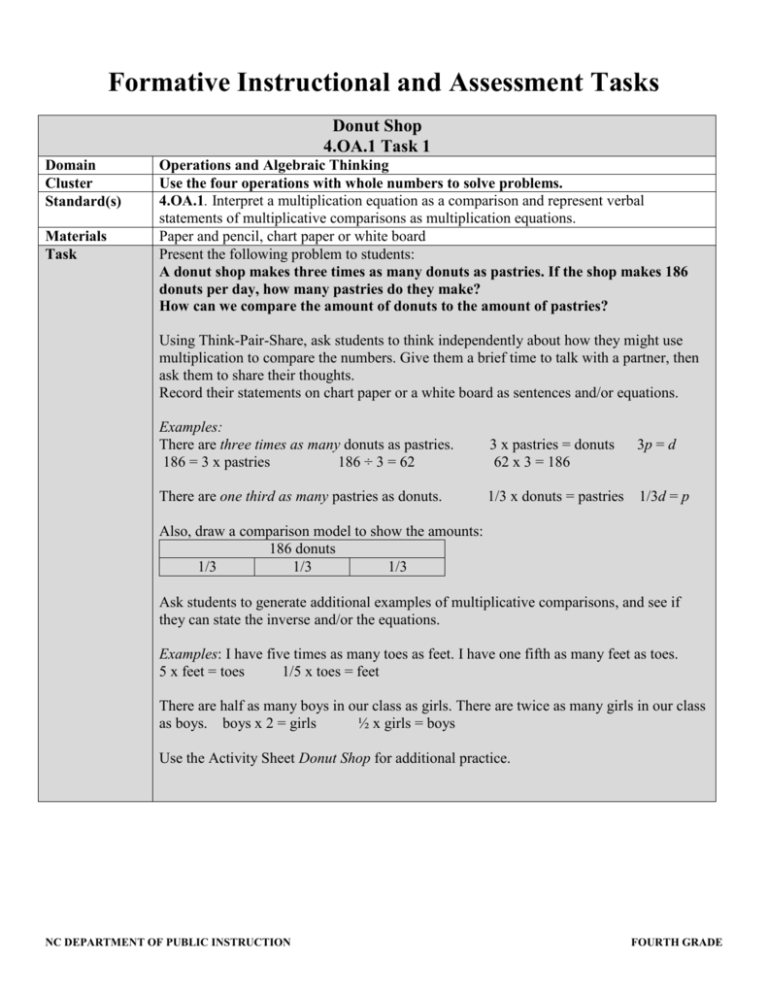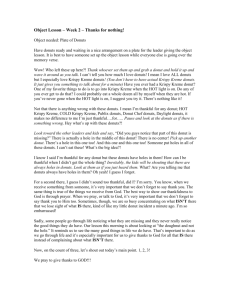4.OA.1 Task 1 - 3
advertisement

Formative Instructional and Assessment Tasks Donut Shop 4.OA.1 Task 1 Domain Cluster Standard(s) Materials Task Operations and Algebraic Thinking Use the four operations with whole numbers to solve problems. 4.OA.1. Interpret a multiplication equation as a comparison and represent verbal statements of multiplicative comparisons as multiplication equations. Paper and pencil, chart paper or white board Present the following problem to students: A donut shop makes three times as many donuts as pastries. If the shop makes 186 donuts per day, how many pastries do they make? How can we compare the amount of donuts to the amount of pastries? Using Think-Pair-Share, ask students to think independently about how they might use multiplication to compare the numbers. Give them a brief time to talk with a partner, then ask them to share their thoughts. Record their statements on chart paper or a white board as sentences and/or equations. Examples: There are three times as many donuts as pastries. 186 = 3 x pastries 186 ÷ 3 = 62 3 x pastries = donuts 62 x 3 = 186 3p = d There are one third as many pastries as donuts. 1/3 x donuts = pastries 1/3d = p Also, draw a comparison model to show the amounts: 186 donuts 1/3 1/3 1/3 Ask students to generate additional examples of multiplicative comparisons, and see if they can state the inverse and/or the equations. Examples: I have five times as many toes as feet. I have one fifth as many feet as toes. 5 x feet = toes 1/5 x toes = feet There are half as many boys in our class as girls. There are twice as many girls in our class as boys. boys x 2 = girls ½ x girls = boys Use the Activity Sheet Donut Shop for additional practice. NC DEPARTMENT OF PUBLIC INSTRUCTION FOURTH GRADE Formative Instructional and Assessment Tasks Level I Limited Performance The student has difficulty restating the comparison situation in his or her own words. They might struggle to determine which amount is more or less. They may be able to generate one equation to compare amounts but will have difficulty stating its inverse. This student will rely on models to make sense of the situations and may need assistance creating models as a tool for writing the appropriate equations. 1. 2. 3. 4. 5. 6. 7. 8. Rubric Level II Not Yet Proficient The student can create a model to compare the amounts multiplicatively and can use the model to generate a multiplication equation, but is not consistently correct. Level III Proficient in Performance With consistency and accuracy, the student is able to state the comparison situations in his or her own words and can generate multiplication equations to describe them. They can draw a model that clearly compares two or more amounts multiplicatively. Standards for Mathematical Practice Makes sense and perseveres in solving problems. Reasons abstractly and quantitatively. Constructs viable arguments and critiques the reasoning of others. Models with mathematics. Uses appropriate tools strategically. Attends to precision. Looks for and makes use of structure. Looks for and expresses regularity in repeated reasoning. Additional Resource: http://www.mathplayground.com/thinkingblocks.html (multiplication link) NC DEPARTMENT OF PUBLIC INSTRUCTION FOURTH GRADE Formative Instructional and Assessment Tasks Donut Shop Show your thinking using pictures, numbers, or words. 1. At the party, Emile ate 2 donuts. Lucas ate four times as many donuts as Emile. How many donuts did they eat altogether? 2. Frank ordered 24 cookies from the donut shop. That is three times as many cookies as Jenny ordered and six times as many cookies as Barb ordered. How many cookies did they order altogether? How many more cookies did Frank order than Jenny and Barb together? 3. The donut shop made 28 chocolate donuts. That is 7 times as many strawberry donuts as they made. How many more chocolate donuts did the shop make than strawberry donuts? NC DEPARTMENT OF PUBLIC INSTRUCTION FOURTH GRADE Formative Instructional and Assessment Tasks 4. Students in Mr. Juarez’s class predicted the number of donuts they could eat. The chart below shows their predictions. Rosa Jeremy Frank Jill Emile Troy Sandy Lucas Shante Molly 2 18 4 6 3 14 9 12 36 8 Compare these numbers in as many ways as you can. Example: Shante said he could eat three times as many donuts as Lucas. NC DEPARTMENT OF PUBLIC INSTRUCTION FOURTH GRADE Formative Instructional and Assessment Tasks ANSWER KEY for Donut Shop 1. Emile: 2 donuts Lucas: 8 donuts Altogether: 10 donuts 4x2=8 8 + 2 = 10 or (4 x 2) + 2 = 10 2. Frank: 24 cookies Jenny: 24 ÷ 3 = 8 8 x 3 = 24 1/3 x 24 = 8 Barb: 24 ÷ 6 = 4 6 x 4 = 24 1/6 x 24 = 4 Altogether: 24 + 8 + 4 = 36 Frank ordered 24 cookies and together, Jenny and Barb ordered 12 cookies. 24 - 12 = 12 Frank ordered 12 more cookies than Jenny and Barb together. 3. 28 = 7 x s 28-4 = 24 donuts. s = 4 (strawberry donuts) The shop made 24 mode chocolate donuts than strawberry 4. Answers will vary but should use multiplicative relationships between the numbers in the chart. Rosa Jeremy Frank 2 18 4 Jill 6 Emile Troy Sandy Lucas Shante Molly 3 14 9 12 36 8 Possible answers: Jeremy said he could eat nine times as many donuts as Rosa, and she said she could eat one ninth as much as him. Jill said she could eat twice as much as Emile, three times as much as Rosa, half as much as Lucas, one third as much as Jeremy, and one sixth as much as Shante. Emile will eat one third as much as Sandy. Sandy will eat three times as much as Emile. *Frank will eat two thirds as much as Jill. *Sandy will eat ¾ as much as Lucas. NC DEPARTMENT OF PUBLIC INSTRUCTION FOURTH GRADE







